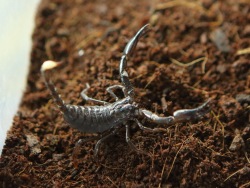The Aquarium becomes home to a scorpion for the first time

The Tropical Rain Forest exhibit has welcomed about a hundred newcomers: bird spiders, chameleons, lizards, several species of frogs and a scorpion. Among the new arrivals there are species that have never been represented in the Aquarium’s collection before - for example, the Asian forest scorpion and the fire skink.
“This is the first time a scorpion has arrived at our Aquarium, it is an Asian forest scorpion which is still very small — some four centimeters in length: as soon as the arachnid grows larger, we will place it in the exhibit,” said Ilya Kuzora, Specialist at the Tropical Rain Forest Department. “This scorpion is relatively harmless, the effect of its venom is much like that of a bee. The scorpion consumes insects it usually preys on at night, and when hunting, it does not typically use the sting but simply grabs and eats its victim. One of four subspecies of the Asian forest scorpion can reproduce through parthenogenesis, that is, females breed without any contribution from a male, and the offspring are exact genetic clones of their mother. We do not know for sure which subspecies our scorpion belongs to, and probably, this single individual will produce young. That said, we will find out this as well as the sex of our scorpion later on.”
The new additions also include five species of bird spiders. One of them — the Colombian giant tarantula — has a unique trait. It is the only bird spider species whose back legs are equipped with spines: in case of danger the spider hits an intruder with them. Two male Brazilian white-knee tarantulas have arrived to become “boyfriends” to the female residing in the Tropical Rain Forest exhibit: the first attempts to introduce them to each other will be made in about six months.
“The female fire skink has laid eggs since it came to the Aquarium, and we hope that its young will emerge soon,” said Artyom Gerasimenko, Principal Specialist at the Tropical Rain Forest Department. “Our panther chameleon has been joined by two females, now they are getting used to each other. Another addition are three cloaked moss frogs: these Vietnamese amphibians are already living at the Aquarium but we need new specimens to participate in the breeding program. Interestingly, the species was described just a little while ago — in 2011.”
The Aquarium’s collection has been enlarged with six African green toads. Despite their common name, one subspecies of these toads also occurs on the Italian islands of Sicily, Lampedusa and some others. Besides, the Aquarium has obtained several pied warty frogs. They live and breed in tree holes, and though nocturnal, the frogs usually spawn in the daytime.